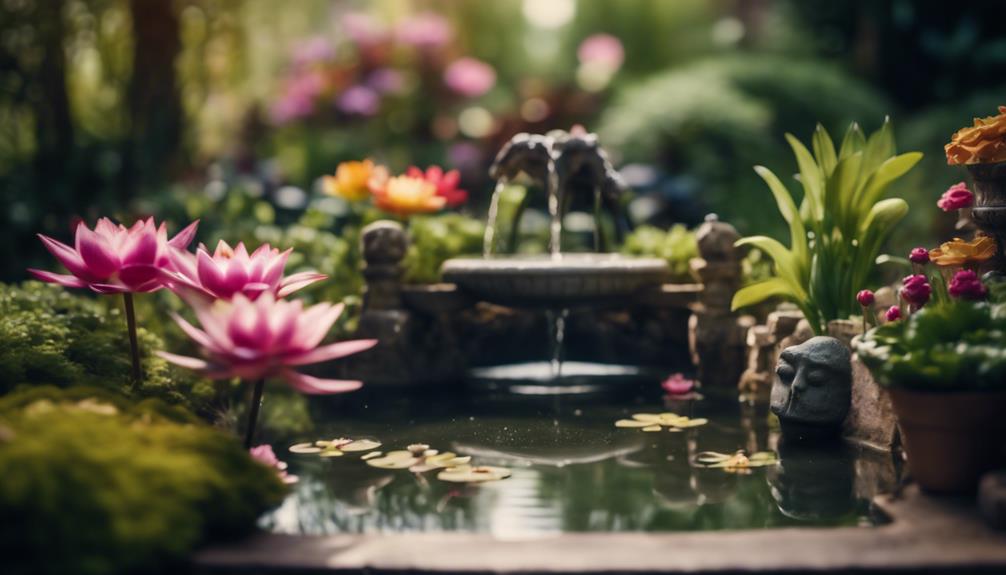You've invested in a beautiful small garden water feature, and now it's vital to maintain it properly to guarantee its durability and peak performance. To keep your water feature running smoothly, regularly clean your skimmer and pump, check and maintain the water level, and identify and fix any leaks. Seasonal care, such as preparing for winter, is also essential. Don't forget to trim nearby foliage and consider professional maintenance if needed. By following these tips, you'll be well on your way to enjoying your water feature for years to come. Now, learn how to tackle these tasks and more in-depth to keep your water feature thriving.
Table of Contents
Key Takeaways
- Regularly clean the skimmer and filter mats to prevent clogs and ensure clear water, and replace filter mats every two years.
- Maintain the ideal water level, 3/4-inch below the skimmer mouth, to prevent overflowing and evaporation, and consider installing an autofill device.
- Scan the perimeter of the pond or stream regularly for signs of leaks, and address them promptly to prevent water loss and maintain water feature health.
- Adapt your maintenance routine to the seasons, with more frequent debris removal in fall and winter, and prepare for winter by deciding whether to keep the pond running or shut it down.
- Regularly test the water pH, check for signs of algae growth, and remove debris and sediment to maintain water clarity and quality.
Understand Skimmer Functions
To keep your small garden water feature running smoothly, you need to understand how your skimmer works.
Fundamentally, the skimmer is designed to sweep the surface of the water, collecting leaves, twigs, seeds, and other debris that falls or blows into the water. Inside the skimmer, there's a debris basket that collects all the unwanted stuff, and a filter mat that catches any debris that slips past the basket.
This two-stage system guarantees your water feature remains clean and clear.
As the skimmer removes debris and excess water from the surface, regular cleaning of the skimmer and its components is crucial to prevent clogs and damage.
Remember, the filter mat typically lasts around two years before needing replacement. Additionally, cleaning the filter screen on the bottom of the pump can improve water flow.
Maintain Water Levels Properly
Now that you've got a handle on how your skimmer works, it's time to focus on maintaining the ideal water level in your small garden water feature.
The ideal level is about 3/4-inch below the top of the skimmer mouth, which prevents water from overflowing and reduces evaporation.
You should regularly check the water level, especially during hot and dry days, and add water as needed to maintain perfect levels and prevent pump damage.
Inadequate water levels can lead to pump damage and reduced lifespan, so vital monitoring and adjustment of water levels regularly is necessary to prevent equipment failure.
Consider installing an autofill device to automate water level monitoring and maintenance, ensuring your water feature operates efficiently and safely.
Proper water level maintenance is vital, especially during winter months when water features are more prone to freezing and damage from ice formation.
Identify and Fix Leaks
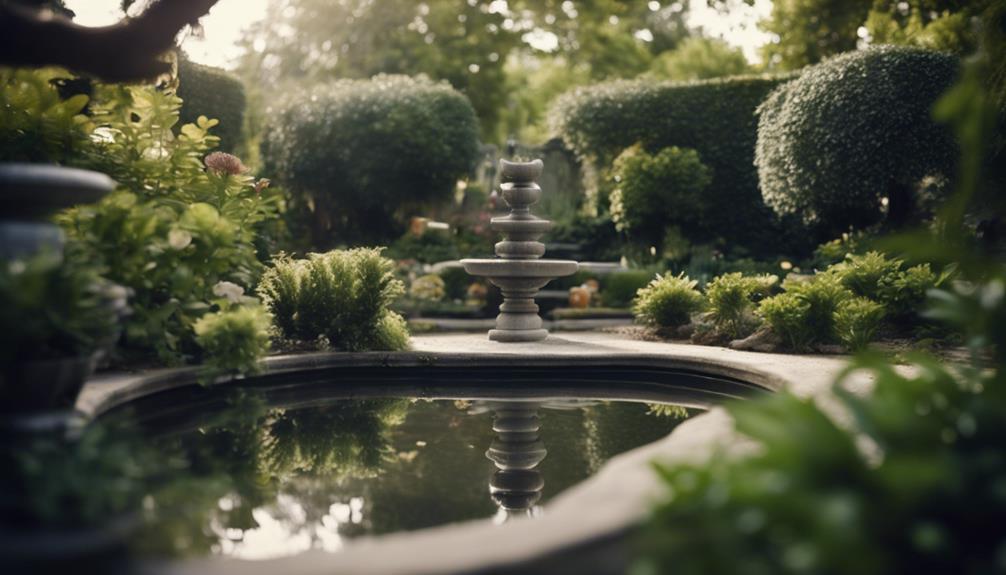
It's time to identify and fix leaks in your small garden water feature.
You'll want to regularly check for wet areas along the perimeter of your pond, waterfall, or stream, as these can indicate water trickling over the edge of the liner.
Check for Wet Areas
Regularly scan the perimeter of your pond, waterfall, or stream to catch wet areas that may signal leaks, as these can lead to water trickling over the edge of the liner due to ground settling. It's vital to identify and address these issues promptly to prevent water loss and maintain the overall health and functionality of your water feature.
Verify slow-moving sections of the stream or waterfall aren't obstructed by leaves, plants, or debris, which can displace water and cause it to flow over the back side of the filter.
Pack additional soil under the liner to raise the edge above the water level to fix leaks, as this will prevent water from flowing over the liner.
Leaks can occur along the perimeter of waterfalls and streams due to ground settling, so it's imperative to monitor these areas regularly.
Identify and fix leaks promptly to prevent water loss and maintain the overall health and functionality of the water feature.
Keep an eye out for any signs of water seepage or erosion around the water feature, as these can be indicative of underlying leaks.
Fix Leaks Quickly
Catch leaks before they cause significant water loss by scanning the perimeter of your pond, waterfall, or stream for wet areas, which can signal leaks due to ground settling or other issues.
You'll want to check for these wet spots during heavy rainfall or when the water level is low, as they can be indicative of a more serious problem.
Don't forget to inspect slow-moving sections of your stream or waterfall, making sure they're not obstructed by leaves, plants, or debris, which can also lead to water seepage and leaks.
To fix leaks, you can try packing additional soil under the liner to raise the edge above the water level.
If the leak is significant or you're unsure of how to repair it, consider consulting a professional.
Regular monitoring of the water level and perimeter inspections can help you identify leaks early on, preventing more extensive damage and costly repairs.
By staying on top of leaks, you can enjoy your outdoor fountain or small garden water feature without worrying about water loss or damage.
Perform Seasonal Water Care
As you shift through the seasons, it's vital to adapt your water care routine to guarantee your small garden water feature remains healthy and functional. Performing seasonal water care is imperative for pond maintenance, and it's not as intimidating as it sounds.
Fall and winter require more frequent debris removal to prevent water from turning brown, and it's vital to prepare for winter by deciding whether to keep the pond running or shut it down. Store pumps in a frost-free location, submerged in a bucket of water to keep seals from drying, and consider adding a floating de-icer to prevent ice dams from forming during winter.
Spring is a good time to perform a full clean-out of the pond, ideally before the water temperature reaches 55°F, to remove any debris that may have accumulated over the winter.
During seasonal changes, monitor the water feature regularly to confirm it's functioning properly, and add water as needed to counteract evaporation and water loss.
Regular seasonal maintenance is vital to prevent equipment damage and prolong the lifespan of the water feature.
Clean Fountain and Pump Regularly
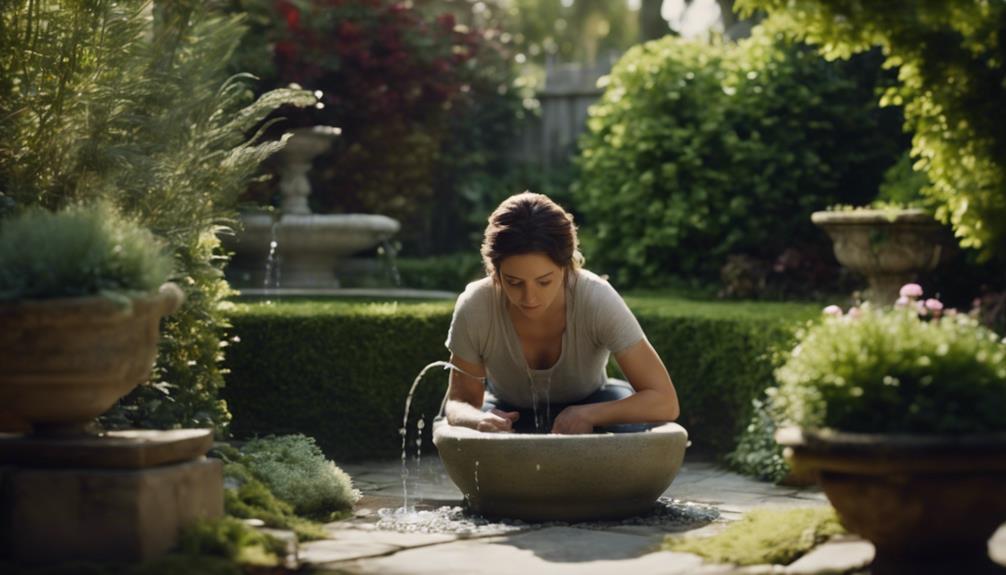
As you maintain your small garden water feature, making certain to clean the fountain and pump regularly is crucial for achieving peak operation and longevity.
You'll want to focus on cleaning fountain parts, performing frequent pump maintenance, and making regular water checks to prevent issues like buildup, overheating, and equipment failure.
Clean Fountain Parts
You should clean your fountain and pump every 1-3 months to remove dirt, debris, and buildup that can affect their performance. This regular maintenance is vital to guarantee your fountain continues to function properly and efficiently.
Failure to clean the pump can lead to overheating and reduced lifespan, while cleaning the fountain helps prevent bacteria and algae growth.
Check the water level regularly and top it off as needed to prevent pump damage and maintain proper circulation.
Cleaning the pump according to the manufacturer's instructions removes blockages and buildup, yielding peak performance.
Regular cleaning helps maintain fountain performance, prevents equipment damage, and prolongs the lifespan of the fountain and pump.
Cleaning your fountain parts helps to leave your water feature looking its best, free from dirt and debris.
Frequent Pump Maintenance
By incorporating regular cleaning into your routine, you'll be able to identify and address any potential issues with your pump before they cause problems. This is vital for maintaining a healthy water flow and ensuring your small garden water feature continues to operate smoothly.
When it comes to pump maintenance, a key requirement is to check and clean the pump filter regularly. This will prevent debris from building up and reducing water flow.
You should also inspect the pump's impeller and volute for any blockages or damage. Clean or replace these parts as needed to maintain peak performance.
Additionally, make sure to check the pump's electrical connections and tighten any loose connections.
Regular Water Checks
Performing regular water checks is crucial to maintaining a healthy and thriving small garden water feature, as it allows you to detect and address any issues before they escalate.
By checking the water regularly, you'll be able to identify problems early on, preventing them from becoming major headaches.
Check the water level: Make sure it's at the recommended level for your specific feature.
Look for signs of algae growth: If you notice any algae, take steps to remove it and prevent its return.
Test the water pH: Verify it's within the acceptable range for your feature and plants.
Check for debris and sediment: Remove any twigs, leaves, or other debris that may be affecting water flow or quality.
Check the water clarity: Make sure the water is clear and free of cloudiness or murkiness.
Prevent Algae Growth Effectively
Regularly cleaning your small garden water feature and maintaining good water circulation helps prevent algae growth from getting out of hand.
You'll want to remove any debris, such as leaves or twigs, that can contribute to algae growth. You can use a skimmer or a net to do this. Additionally, consider adding an algae-preventing supplement to your outdoor water. These supplements typically contain bacteria that break down organic matter, reducing the likelihood of algae growth.
It's also essential to guarantee your water feature has adequate aeration.
You can achieve this by installing a pump or a fountain, which will increase oxygen levels in the water. This will help prevent the stagnation that algae thrive in.
By following these tips, you'll be able to enjoy your small garden water feature without the hassle of constant algae growth. Remember, regular maintenance is key to keeping your outdoor water feature looking its best.
Manage Water Level and Quality
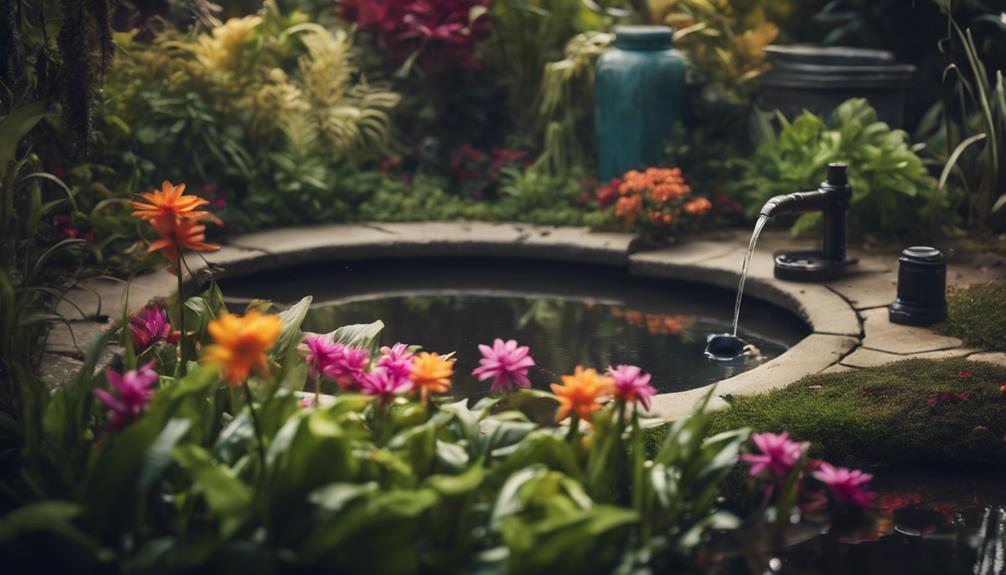
You'll need to keep a close eye on your water feature's water level to guarantee it's operating efficiently and prevent potential problems. Maintaining the right water level is vital for keeping your pump running smoothly and preventing damage.
Set the ideal water level at about 3/4-inch below the top of the skimmer mouth to prevent overflow and mess.
Regularly check and top off the water level as needed to prevent pump damage and maintain proper circulation.
Consider installing an autofill device to automate water level monitoring and maintain a consistent level.
Keep an eye out for signs of leaks along the perimeter of your pond, waterfall, or stream, which can occur due to ground settling.
Proper water level maintenance also helps prevent bacteria and algae growth, keeping your water feature clean and clear.
Protect Fountain From Freezing
During the winter months, it's vital to take steps to protect your fountain from freezing temperatures, which can cause damage to the pump, pipes, and other components.
You'll want to lower the water level to about 1-2 inches below the nozzle or spout to prevent ice from forming and expanding, which can crack the fountain's material.
Make sure the pump is fully submerged in water to keep it from freezing. You can also add a fountain heater or a floating de-icer to keep the water from freezing.
If you live in an area with extremely cold temperatures, consider draining the fountain completely and storing the pump and other components in a dry place.
Additionally, insulate the fountain's pipes with foam insulation or wrap them with heat tape to prevent freezing.
Trim Foliage and Prevent Damage
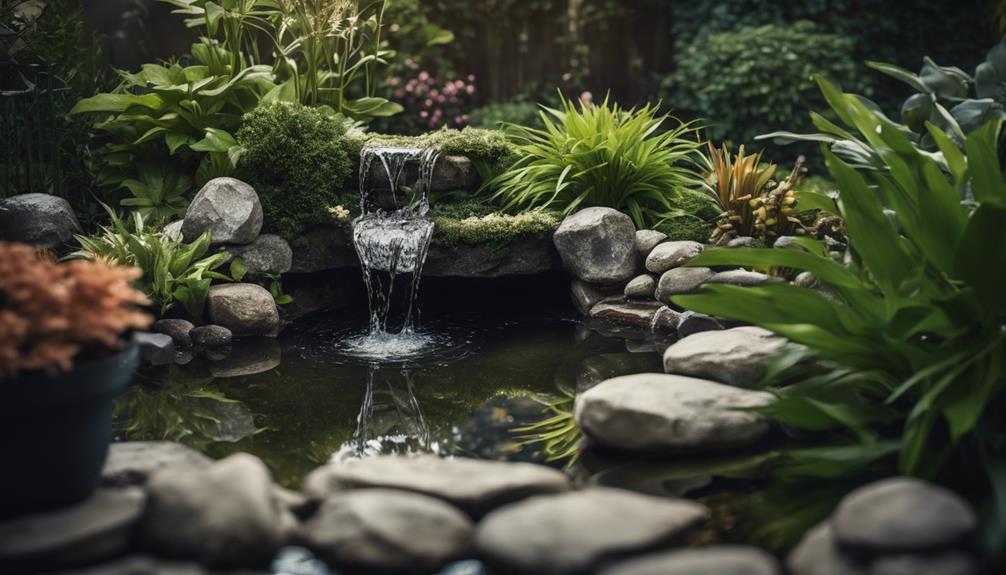
After protecting your fountain from freezing temperatures, turn your attention to the surrounding foliage, which can cause damage to your water feature if left unattended.
Overgrown plants can clog your fountain's pump, filters, and pipes, leading to costly repairs or even complete system failure.
To avoid this, make sure to trim foliage regularly to keep it from encroaching on your water feature.
Trim back any plants or trees that are within 3-5 feet of your fountain to prevent leaves and debris from falling in.
Remove any dead or dying plant material to prevent it from decomposing in your fountain.
Make sure to dispose of any clippings or debris properly to prevent them from ending up in your fountain.
Consider using plants that are specifically designed for small gardens and water features, as they tend to be more compact and require less maintenance.
Set a regular schedule to check and trim your foliage to prevent it from getting out of control.
Consider Professional Maintenance
If you're short on time or not comfortable with DIY maintenance, consider enlisting the help of a professional to keep your small garden water feature running smoothly.
Professional maintenance can range from $50 to $150 per month, depending on the complexity of the feature and the frequency of visits.
By hiring a pro, you can take the task off your to-do list and guarantee that your water feature is properly maintained to prevent equipment damage and prolong its lifespan.
Regular maintenance by a professional can help identify potential issues before they become major problems, saving you time and money in the long run.
These experts have the knowledge and expertise to handle complex maintenance tasks, such as repairing pumps and pipes, and can provide guidance on how to properly care for your water feature according to the manufacturers' instructions.
By enlisting professional maintenance, you can enjoy your water feature with peace of mind, knowing that it's being properly maintained and cared for.
With their help, you can focus on relaxing and enjoying your outdoor space, rather than worrying about upkeep.
Frequently Asked Questions
How Do You Keep Water Clean in a Small Water Feature?
You keep water clean in a small water feature by regularly testing the water for pH and chlorine levels, cleaning the filter every 2-3 weeks, and making adjustments as needed to maintain a balanced ecosystem.
How to Keep Small Outdoor Fountain Water Clean?
"An ounce of prevention is worth a pound of cure." To keep your small outdoor fountain water clean, you'll want to prioritize fountain aeration and water circulation, ensuring oxygen-rich water and preventing stagnation.
What Can I Put in My Small Fountain to Prevent Algae?
You can add a clarifier or algaecide tablets to your small fountain to prevent algae growth, and introduce beneficial bacteria to maintain a healthy balance, keeping your water feature clean and clear.
How to Care for an Outdoor Water Feature?
'You're part of the 75% of homeowners who find outdoor water features calming! To care for yours, prep for winter by cleaning and protecting your fountain's design, and perform regular inspections to guarantee it runs smoothly and efficiently.'
Conclusion
As you tend to your small garden water feature, remember that maintenance is an ongoing dance.
It's a delicate balance between nurturing life and preventing chaos.
By following these 10 tips, you'll be well on your way to creating a serene oasis that brings joy to all who behold it.
So, take a deep breath, roll up your sleeves, and plunge into action – your water feature's beauty is in your hands.

